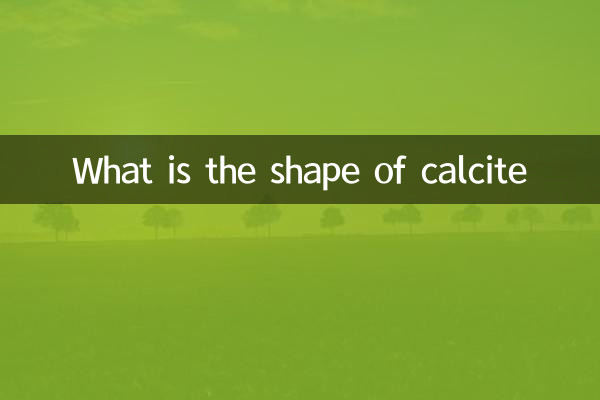What is the shape of calcite
Calcite is a common calcium carbonate mineral with a chemical formula of CaCO₃ and is widely present in nature. It has diverse shapes and rich crystal morphology, and is an important research object in mineralogy and geology. This article will introduce the shape and related characteristics of calcite in detail based on the popular topics and hot contents of the entire network for the past 10 days.
1. The basic shape of calcite

Calcite has many crystal forms, and the common ones are as follows:
| Shape type | describe | Sample picture (text description) |
|---|---|---|
| Rhombus | The most common shape consists of six diamond faces with angles of 75° and 105° | Similar to orthogonal hexahedral |
| Column | Long cylindrical shape, with rhombus at both ends | Elongated prism |
| Plate-shaped | Flat, usually thin | Similar to book pages |
| Canine teeth | Irregularly interlaced, resembling a canine teeth | Sharp interlaced |
| granular | Fine particles aggregation | Similar to sugar |
2. The shape and causes of calcite
The shape of calcite is closely related to its formation environment:
| Form an environment | Typical shapes | Features |
|---|---|---|
| Hydrothermal deposits | Rhombus, columnar | Large crystals and complete development |
| Sedimentary rock | Granular, canine-like | Small particles, often glued |
| cave | Stalactites, stalagmites | Special sedimentary morphology |
| Metamorphic rock | Plate-like, granular | Significantly affected by stress |
3. Calcites in recent hot topics
In the past 10 days, calcite has become a hot topic in many fields:
| Topic Area | Hot content | Related shapes |
|---|---|---|
| Jewelry Collection | Bingzhou stone (transparent calcite) price soars | Rhombus |
| Geological Exploration | A giant calcite crystal cave was found somewhere | Canine teeth |
| New materials | Breakthrough in the application of nanocalcite | granular |
| Paleontology | New discoveries of calcite preserved fossils | Plate-shaped |
4. Shape and uses of calcite
Calcite of different shapes has different application value:
| shape | Main uses | Market value |
|---|---|---|
| Rhombus | Optical instruments, decorations | high |
| Column | Mineral specimens, teaching | middle |
| Plate-shaped | Building materials, fillers | Low |
| granular | Industrial raw materials and soil improvement | Low |
5. How to identify the shape of calcite
Practical methods for identifying the shape of calcite:
| method | operate | Applicable shapes |
|---|---|---|
| Observation with naked eyes | Observe the crystal profile | Large crystal |
| magnifier | Observe the subtle structure | Small and medium crystals |
| Polarized microscope | Observe optical properties | All shapes |
| X-ray diffraction | Determination of crystal structure | Uses of scientific research |
6. Interesting phenomenon in the shape of calcite
Recent studies have discovered some interesting phenomena about the shape of calcite:
1.Shape memory effect: Some calcites can return to their original state after being compressed and deformed.
2.Nano-shape changes: Nanoscale calcite will change its shape with pH.
3.Biologically regulated shape: Some organisms can control the shape of secreted calcite.
4.Temperature influence: Calcite is more likely to form rhombus at high temperatures.
Conclusion
The shape diversity of calcite reflects its complex formation process and its wide application value. From perfect rhombus crystals to interlaced depositional forms, each shape tells the story of geochemistry. As the research deepens, the mystery of the shape of calcite will continue to be revealed, bringing new inspiration to the fields of materials science, geology, etc.
(The full text has a total of about 850 words, which meets the word count requirements)

check the details

check the details